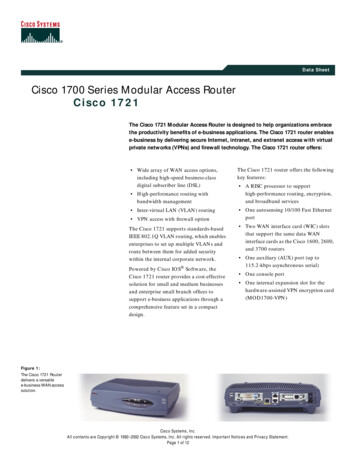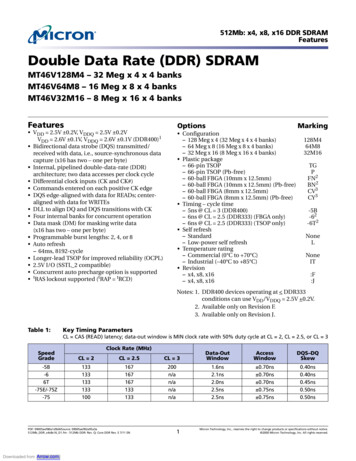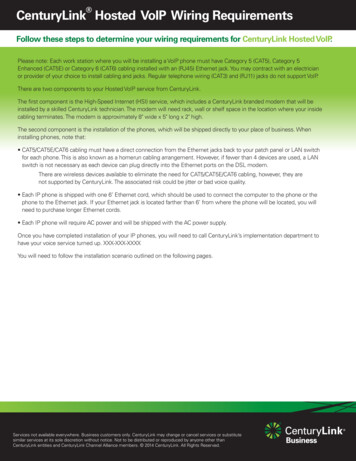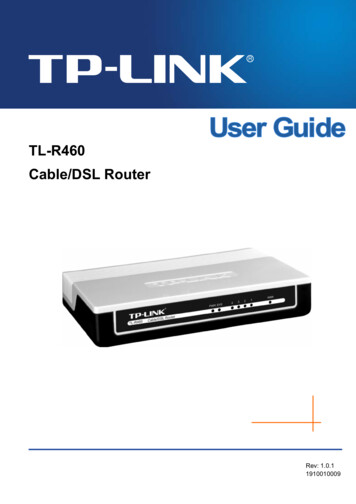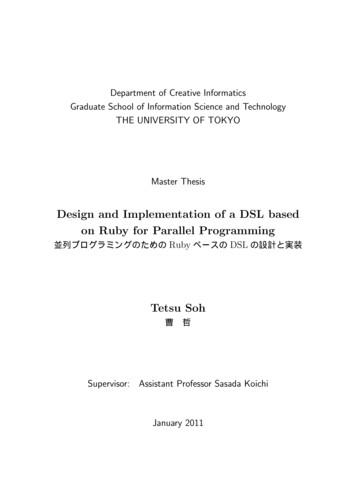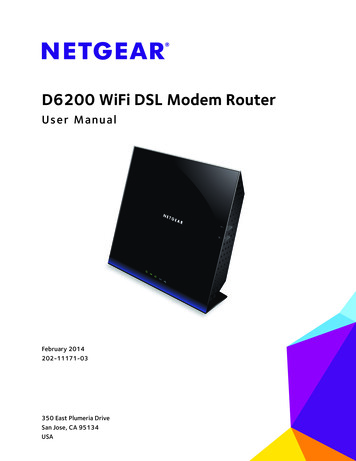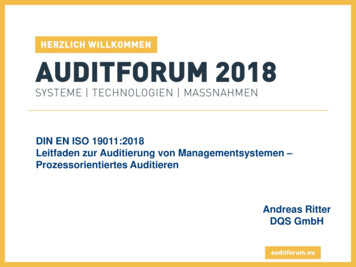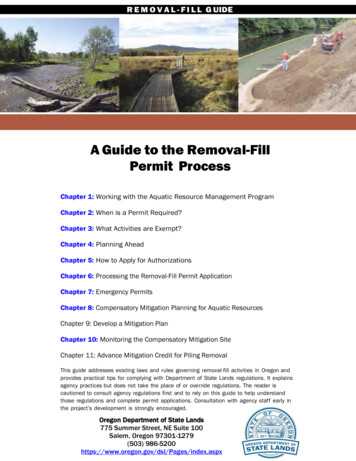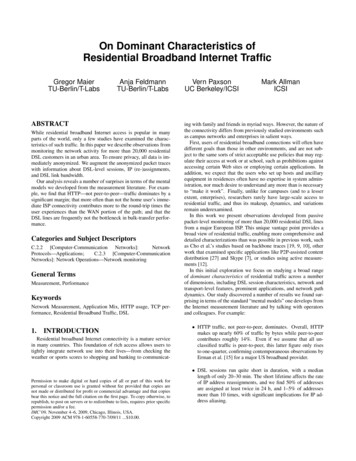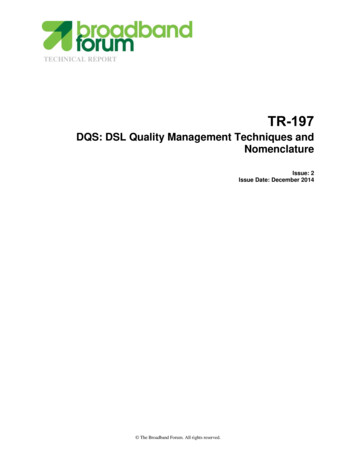
Transcription
TECHNICAL REPORTTR-197DQS: DSL Quality Management Techniques andNomenclatureIssue: 2Issue Date: December 2014 The Broadband Forum. All rights reserved.
DQS: DSL Quality Management Techniques and NomenclatureTR-197 Issue 2NoticeThe Broadband Forum is a non-profit corporation organized to create guidelines for broadbandnetwork system development and deployment. This Broadband Forum Technical Report hasbeen approved by members of the Forum. This Broadband Forum Technical Report is notbinding on the Broadband Forum, any of its members, or any developer or service provider. ThisBroadband Forum Technical Report is subject to change, but only with approval of members ofthe Forum. This Technical Report is copyrighted by the Broadband Forum, and all rights arereserved. Portions of this Technical Report may be copyrighted by Broadband Forum members.The Forum draws attention to the fact that it is claimed that compliance with this Specificationmay involve the use of a patent ("IPR") concerning TR-197 Issue 2. The Forum takes no positionconcerning the evidence, validity or scope of this IPR.The holder of this IPR has assured the Forum that it is willing to License all IPR it owns and anythird party IPR it has the right to sublicense which might be infringed by any implementation ofthis Specification to the Forum and those Licensees (Members and non-Members alike) desiringto implement this Specification. Information may be obtained from:Adaptive Spectrum and Signal Alignment, Inc.333 Twin Dolphin Drive, Redwood City, CA 94065, USAAttention is also drawn to the possibility that some of the elements of this Specification may bethe subject of IPR other than those identified above. The Forum shall not be responsible foridentifying any or all such IPR.THIS SPECIFICATION IS BEING OFFERED WITHOUT ANY WARRANTYWHATSOEVER, AND IN PARTICULAR, ANY WARRANTY OF NONINFRINGEMENT ISEXPRESSLY DISCLAIMED. ANY USE OF THIS SPECIFICATION SHALL BE MADEENTIRELY AT THE IMPLEMENTER'S OWN RISK, AND NEITHER the Forum, NOR ANYOF ITS MEMBERS OR SUBMITTERS, SHALL HAVE ANY LIABILITY WHATSOEVERTO ANY IMPLEMENTER OR THIRD PARTY FOR ANY DAMAGES OF ANY NATUREWHATSOEVER, DIRECTLY OR INDIRECTLY, ARISING FROM THE USE OF THISSPECIFICATION.Broadband Forum Technical Reports may be copied, downloaded, stored on a server orotherwise re-distributed in their entirety only, and may not be modified without the advancewritten permission of the Broadband Forum.The text of this notice must be included in all copies of this Broadband Forum Technical Report.December 2014 The Broadband Forum. All rights reservedPage 2 of 76
DQS: DSL Quality Management Techniques and NomenclatureTR-197 Issue 2Issue HistoryIssue Number1Approval Date21 August 201223 March 20142c11 December2014Publication Date12 January 2015Issue EditorDaniel CederholmEricssonChristopher CrootBTChristopher CrootBTChangesOriginalAddition ofinformationrelated toenergysavingCorrection ofInitialisationPolicy textTechnical comments or questions about this Broadband Forum Technical Report should bedirected to help@broadband-forum.org.EditorChris CrootBTchris.croot@bt.comOperations & NetworkManagement WG Co-ChairPeter AdamsAdtranp.f.adams@btopenworld.comCo-ChairChris CrootBTchris.croot@bt.comDecember 2014 The Broadband Forum. All rights reservedPage 3 of 76
DQS: DSL Quality Management Techniques and NomenclatureTR-197 Issue 2TABLE OF CONTENTSEXECUTIVE SUMMARY .61PURPOSE AND SCOPE .71.11.22REFERENCES AND TERMINOLOGY.82.12.22.33PURPOSE . 7SCOPE . 7CONVENTIONS . 8REFERENCES . 8ABBREVIATIONS . 9TECHNICAL REPORT IMPACT .123.13.23.33.4ENERGY EFFICIENCY. 12IPV6 . 12SECURITY. 12PRIVACY . 124INTRODUCTION.135DSL QUALITY IMPAIRMENTS AND INDICATORS .155.1CROSSTALK NOISE . 155.1.1 Stationary Crosstalk. 165.1.2 Short-Term Stationary Crosstalk . 165.1.3 Time-varying Crosstalk . 175.2IMPULSE NOISE . 175.2.1 Repetitive Electrical Impulse Noise (REIN) . 175.2.2 Prolonged Electrical Impulse Noise (PEIN). 185.2.3 Single High level Impulse Noise Event (SHINE) . 195.3RADIO FREQUENCY INTERFERENCE (RFI). 195.4INTRINSIC NOISE . 206DSL QUALITY MANAGEMENT .226.1DYNAMIC SPECTRUM MANAGEMENT (DSM) . 236.1.1 Levels of coordination. 236.2DYNAMIC LINE CODE MANAGEMENT (DLCM) . 246.3DSL EMBEDDED CAPABILITIES . 246.3.1 Rate Configuration. 256.3.2 Margin Configuration . 256.3.3 Transmit Power and Spectrum Configuration . 266.3.4 Energy Efficiency for Rate, Margin, and Transmit Power . 266.3.5 Channel Initialization Policies . 276.3.6 Re-initialization Policy . 276.3.7 Upstream Power Back-off (UPBO) . 286.3.8 Downstream Power Back-off (DPBO) . 286.3.9 Virtual Noise (VN) . 29December 2014 The Broadband Forum. All rights reservedPage 4 of 76
DQS: DSL Quality Management Techniques and NomenclatureTR-197 Issue 26.3.10 SOS - Emergency Rate Adjustment . 316.3.11 Seamless Rate Adaptation (SRA) . 336.3.12 Impulse Noise Protection (INP) . 376.3.13 Retransmission (RTX) . 406.3.14 Vectoring . 446.3.15 Impulse Noise Monitoring (INM). 476.4TEST MEASUREMENT CAPABILITIES . 496.4.1 Single Ended Line Test (SELT) . 496.4.2 Dual Ended Line Test (DELT) . 526.4.3 Metallic Line Test (MELT). 556.5EXTERNAL DQM TECHNIQUES . 586.5.1 Static Quality Management (SQM) Techniques . 586.5.2 Dynamic Spectrum Management (DSM) Techniques . 606.5.3 Dynamic Line Management (DLM) Techniques . 636.5.4 Automatic Margin Adaptation (AMA) . 636.5.5 Tiered Rate Adaption (TRA) . 657LOW POWER STATES TECHNIQUES.677.1LOW-POWER TRANSMISSION STATES TECHNIQUES . 677.1.1 Objective – basic variant . 677.1.2 Target . 687.1.3 Involved parameters and/or line characteristics . 687.1.4 DQM Technique methods – basic variants . 687.1.5 Caveats, trade-offs and limitations . 707.1.6 Related DQM techniques for escalated/combined strategies on the line . 70[A.1]CONSIDERATIONS FOR ADSL2/2PLUS . 72[A.2]CONSIDERATIONS FOR VDSL2 . 73List of FiguresFigure 1: The different paths of crosstalk . 16Figure 2: Measurement of REIN noise . 18Figure 3: Bit-loading from a line in the Sweden that is disturbed by AM radio . 20Figure 4: Noise Margins . 34Figure 5: A Reed-Solomon codeword . 39Figure 6: Retransmission implementation schema . 43Figure 7: Network Access Architecture supporting vectored VDSL2 . 45Figure 8: INM scheme . 48Figure 9: DELT QLN measurement of a REIN disturber (broken power supply) . 53Figure 10: Hlog(f) from DELT measurements of a one section line, a line with a 30 m bridgedtap and a line with a 200 m bridged tap. . 55Figure 11: MELT reference model . 57Figure 12: Example MDF PSD mask . 58Figure 13: Example of target noise margin (TARSNRM) profiling schemes for AMA . 64Figure 14: Comparison of Tiered Rate-Adaptive and Rate-Adaptive profiles . 66December 2014 The Broadband Forum. All rights reservedPage 5 of 76
DQS: DSL Quality Management Techniques and NomenclatureTR-197 Issue 2Executive SummaryDSL Quality Management is a concept devised by the Broadband Forum to cover a range oftechniques and strategies for the proactive monitoring and configuration of DSL lines to assureappropriate quality and stability for the services the lines are delivering. There are variouspublished techniques and in-built capabilities in standardized DSL transceivers that areencompassed by DQM. These techniques and capabilities generate a rich nomenclature.Sometimes the nomenclature and techniques are used by commercial products or within theoperational work-flows for access networks. As an aid to understanding DQM and the series ofBroadband Forum Technical Reports in the DSL Quality Suite, TR-197 describes the publishedtechniques and DSL capabilities and introduces the nomenclature used.Issue 2 of TR-197 includes new material on the use and impact of energy saving techniques inthe context of DQM.December 2014 The Broadband Forum. All rights reservedPage 6 of 76
DQS: DSL Quality Management Techniques and Nomenclature1TR-197 Issue 2Purpose and Scope1.1PurposeThe purpose of this Technical Report, TR-197, is to define a common nomenclature and aunified framework to describe functionalities, tools, techniques and strategies that are alreadyavailable or under development for the support of DSL Quality Management (DQM) [14]. Inbuilding such a taxonomy of DQM “enablers” the focus is on the issues and problems to besolved rather than the implemented algorithms. Furthermore, the variants of DQM techniquesthat can bring energy efficiency benefits are described in conjunction with the trade-offs andconstraints related to the DSL quality and stability requirements that remain a key priority forOperators. Enhancing the energy efficiency of DSL broadband access networks has become anessential part of the emerging trend towards green Information and Communication Technology(ICT). The variants of DQS techniques that can bring energy efficiency benefits are described inconjunction with the trade-offs and constraints related to the DSL quality and stabilityrequirements that remain a key priority for Operators.1.2ScopeTR-197 provides a unified nomenclature for the techniques and strategies available to addressDSL line stability and quality issues. TR-197 defines a common language to refer to parameters,functionalities and typical network practices in the problem domain specified above. Such an‘alphabet’ is a fundamental prerequisite for the specification of requirements for systemsenabling effective network operation strategies. Using the nomenclature TR-197 describes the inbuilt capabilities in DSL transceivers (defined in ITU-T Recommendations) and the publishedtechniques that fall within the DQM concept.This document identifies DSL configuration and diagnostic parameters and outlines theparameters to optimise data rate, stability and energy efficiency of a DSL network. Techniquesand other appropriate methods are also described here along with the relationship between thethree axes of quality, stability and power saving.Pointers are given to standards defining accuracy requirements and tests for validation andverification of the DSL configuration and diagnostic parameters for DQM.December 2014 The Broadband Forum. All rights reservedPage 7 of 76
DQS: DSL Quality Management Techniques and Nomenclature2TR-197 Issue 2References and Terminology2.1ConventionsThis Technical Report is solely informative and therefore does not contain any normative text.There are no conventions relating to requirements. Normative text is confined to componentdocuments of the DSL Quality Suite.2.2ReferencesThe following references constitute provisions of this Technical Report. At the time ofpublication, the editions indicated were valid. All references are subject to revision; users of thisTechnical Report are therefore encouraged to investigate the possibility of applying the mostrecent edition of the references listed below.A list of currently valid Broadband Forum Technical Reports is published athttp://www.broadband-forum.org .DocumentTitleSourceYear[1]RFC 2119Key words for use in RFCs to IndicateRequirement LevelsIETF1997[2]RFC 2233The Interfaces Group MIB using SMIv2IETF1997[3]G.992.3Asymmetric digital subscriber line transceivers 2(ADSL2)ITU-T2009[4]G.992.5Asymmetric Digital Subscriber Line (ADSL)transceivers – Extended bandwidth ADSL2(ADSL2plus)ITU-T2009[5]G.993.2Very high speed digital subscriber linetransceivers 2 (VDSL2)ITU-T2006[6]G.993.5Self-FEXT cancellation (vectoring) for use withVDSL2 transceiversITU-T2010[7]G.996.2Single-ended line testing for digital subscriberline (DSL)ITU-T2009[8]G.997.1Physical layer management for digital subscriberline (DSL) transceiversITU-T1996[9]G.998.4Improved impulse noise protection for DSLtransceiversITU-T2010[10] TR-100ADSL2/ADSL2plus Performance Test PlanBBF2007[11] TR-114VDSL2 Performance Test PlanBBF2009[12] TR-126Triple Play Services Quality of ExperienceRequirementsBBF2006December 2014 The Broadband Forum. All rights reservedPage 8 of 76
DQS: DSL Quality Management Techniques and NomenclatureTR-197 Issue 2[13] TR-176ADSL2Plus Configuration Parameters for IPTVBBF2008[14] TR-188DSL Quality SuiteBBF2010[15] TR-198DQS: DQM systems functional architecture andrequirementsBBF2010[16] TR-202ADSL2/ADSL2plus Low-Power Mode GuidelinesBBF2010[17] MR-204Energy Efficiency, Dematerialization and the Roleof the Broadband ForumBBF2009[18] Deliverable Position paper on Dynamic SpectrumTF2.2Management (DSM) and Dynamic Line-CodeManagement (DLCM)IST-MUSEproject2005[19] Deliverable Static and Dynamic Spectral ManagementB2.1Analysis - Issue 2IST-MUSEproject2006[20] Deliverable Migration guidelines for DSL from operator’sB2.3viewIST-MUSEproject2005[21] ATIS-PP0600007Dynamic Spectrum ManagementATISCOAST2007[22] NICC ND1513Report on Dynamic Spectrum Management (DSM) NICCMethods in the UK Access Network2010[23] ANSIT1.417Spectrum Management For Loop TransmissionSystems, American National Standard ForTelecommunicationsANSI2003[24] NICC ND1602Specification of the Access Network FrequencyPlan applicable to transmission systemsconnected to the BT Access NetworkNICC2011[25] ATIS0600027Guidance for the Use of Upstream Power BackOff Parameters for ITU-T RecommendationG.993.2 Annex A, Issue 2ATISCOAST20102.3AbbreviationsThis Technical Report uses the following abbreviations:ADSLAMANCOCPEDELTDLCMAsymmetric Digital Subscriber LineAmplitude ModulationAccess NodeCentral OfficeCustomer Premises EquipmentDual Ended Line TestDynamic Line Code ManagementDecember 2014 The Broadband Forum. All rights reservedPage 9 of 76
DQS: DSL Quality Management Techniques and NRFISDTVSELTSHDSLSHINESNRSNRMSRASSMTR-197 Issue 2Dynamic Line ManagementDiscrete Multi-ToneDSL Quality ManagementDSL Quality SuiteDigital Subscriber LineDynamic Spectrum ManagementFrequency Division MultiplexingForward Error CorrectionFar End CrosstalkAmateur radioHigh bit rate Digital Subscriber LineHigh Definition TelevisionInter Arrival TimeImpulse Noise ProtectionImpulse Noise Protection EquivalentInternet Protocol TelevisionLoss Of MarginLong waveMetallic Line TestMedium waveNear End CrosstalkOperations Support SystemProlonged Electrical Impulse NoisePower Spectral DensityQuality of ExperienceQuality of ServiceRepetitive Electrical Impulse NoiseRadio Frequency InterferenceStandard Definition TelevisionSingle Ended Line TestSymmetric High-speed Digital Subscriber LineSingle High-level Impulse NoiseSignal-to-Noise RatioSignal-to-Noise Ratio MarginSeamless Rate AdaptationStatic Spectrum ManagementDecember 2014 The Broadband Forum. All rights reservedPage 10 of 76
DQS: DSL Quality Management Techniques and NomenclatureSWTDDTDMAVDSLVNTR-197 Issue 2Short waveTime Division DuplexingTime Division Multiple AccessVery high-rate Digital Subscriber LineVirtual NoiseDecember 2014 The Broadband Forum. All rights reservedPage 11 of 76
DQS: DSL Quality Management Techniques and Nomenclature3TR-197 Issue 2Technical Report Impact3.1Energy EfficiencyThe scope of TR-197 covers improvements in energy efficiency.3.2IPV6TR-197 has no impact on IPv6.3.3SecurityTR-197 has no impact on security.3.4PrivacyTR-197 has no impact on privacy.December 2014 The Broadband Forum. All rights reservedPage 12 of 76
DQS: DSL Quality Management Techniques and Nomenclature4TR-197 Issue 2IntroductionDSL Quality Management (DQM), per its definition in TR-188 “DSL Quality Suite” [14], aimsto improve the stability, quality and performance of DSL lines. An additional benefit withrespect to these objectives is the ability to improve energy efficiency. Generally speaking, this isachieved by means of “DSL line management techniques” that will be referred to as DQMtechniques in the remainder of this document. A DQM technique modifies (groups of)parameters to achieve certain effects on the line.The essence of a DQM technique is its method, i.e. the concatenation of processes“data collection – analysis/diagnosis – changes on the line(s)” to achieve the goal(s) of thetechnique (e.g. stability increase, quality improvement, service/performance upgrade, etc.).Hence, implicitly a DQM technique is associated with monitoring the line itself and - dependingon each case - it is typically focused on specific parameters associated to the nature of thetechnique.Typically DQM technique categories focus on a given stability/performance “area” of DSLtransmission strictly influenced by a group of parameters configured in the line profile. In otherwords the usual objective of finding the appropriate trade-off between reducing noise influenceand maintaining good bitrates leads to the “tuning” of the DSL line code or the signal spectrum.This introduces two main categories of DQM techniques: Dynamic Line Code Management(DLCM) and Dynamic Spectrum Management (DSM). New transceiver functionalities such asVirtual Noise and Retransmission may be exploited to build up new techniques and in certaincases the combined use of basic techniques leads to structured ones that better fit troublesomeline conditions experienced in real networks. Furthermore line testing techniques such as SELT,DELT and MELT can be utilized to further enhance troubleshooting capabilities and they canalso be used to trigger other DQM methods.Enhancing the energy efficiency of DSL broadband access networks has become increasinglyimportant as part of the emerging trend towards green Information and CommunicationTechnology (ICT). DQM techniques may help improve energy efficiency. Many DSL linestransmit excessive power and are often underutilized. There is a fundamental trade-off betweenperformance, stability, and energy usage. In general, improving one of these three axes meansthat at least one of the others may degrades, although this degradation could be imperceptible insome cases. A DQM system can manage multiple DSL lines to manage the trade-offs betweenthese parameters. Reducing power appropriately on a given line may not decrease the data rate orline stability (depending on the service rate and performance specification) of that line, and itmay sometimes even result in increased data rates or stability for neighbouring lines due tocrosstalk reduction.This Technical Report develops a categorization and description of the building blocks of DQMtechniques and provides guidance for their use in a stand-alone or combined manner. This isdone coherently with the architectural specification of DQM systems provided in TR-198 [15].This Technical Report provides a taxonomy of DQM techniques. It is solely informative andcontains no normative requirements or recommendations regarding the advisability of use of anyDecember 2014 The Broadband Forum. All rights reservedPage 13 of 76
DQS: DSL Quality Management Techniques and NomenclatureTR-197 Issue 2particular technique. Furthermore, specification of the design, implementation or performancecapabilities of any DQM algorithm or technique is outside the scope of this Technical Report.December 2014 The Broadband Forum. All rights reservedPage 14 of 76
DQS: DSL Quality Management Techniques and Nomenclature5TR-197 Issue 2DSL Quality Impairments and Indicators5.1Crosstalk NoiseCrosstalk is one of the major limiting factors on the performance of DSL systems if propermanagement and/or mitigation techniques are not used. It occurs when the electromagneticcoupling between different transmission lines causes interference between the signals. In simplewords this means that the signal from one line is “leaking” into a second line where it is seen asnoise and thus decreases the SNR of the transmission on that line.Twisted pairs are typically grouped into cable binders. Within a binder the lines are located veryclose to each other and the closer they are the higher the coupling and thus the crosstalk will be.The effect of crosstalk can however be decreased by using different twist lengths on differentpairs to reduce the symmetry and thereby reducing the coupling between them. Different binderscan also be twisted around each other so that no two binders are adjacent for long runs, tominimize the crosstalk. The twisting is however not perfectly random and a line is typicallyadjacent to some of the lines in the cable for longer distances than to some other lines in thesame cable. Also, the conductors are not perfectly identical and so there is at least some smallcapacitive unbalance between pairs. This means that typically one line in a cable may experiencemore crosstalk than other lines in the same cable. The level of crosstalk is hence highlydependent on the type and quality of the cable and it will vary from pair to pair and withfrequency.There are two different types of crosstalk, Near End crosstalk (NEXT) and Far End crosstalk(FEXT). NEXT is the crosstalk from a transmitter to a receiver that is located in the same end ofa transmission line. This can cause a severe impairment since the signal sent from the remotetransmitter has been attenuated along the transmission line before reaching the local receiverwhile the leaking signal just was sent out from another local transmitter and thus has not beenattenuated as much. FEXT is the crosstalk leaking into another transceiver on the opposite end ofthe subscriber loop. This means that the induced crosstalk has to travel along the line and boththe signal and the crosstalk will be attenuated by the loop. The different paths of the NEXT andthe FEXT crosstalk are shown in Figure 1.December 2014 The Broadband Forum. All rights reservedPage 15 of 76
DQS: DSL Quality Management Techniques and NomenclatureTR-197 Issue 2FEXT is shown in blue and NEXT in redCO TransmitterSystem1CPE ReceiverSystem 1CO ReceiverSystem 1CPE TransmitterSystem 1CO TransmitterSystem2CPE ReceiverSystem 2CO ReceiverSystem 2CPE TransmitterSystem 2Figure 1: The different paths of crosstalkIn some deployment scenarios the twisted pairs inside a cable binder are used for different typesof DSL services. The crosstalk disturber can therefore originate from transmission lines runningany kind of DSL service e.g. HDSL, SHDSL, ADSL or VDSL. The crosstalk that originatesfrom a signal of the same service as the disturbed signal is often referred to as self crosstalkwhile crosstalk between different types of services are called foreign or alien crosstalk. SelfNEXT can be avoided by using a frequency division multiplexed (FDM) system where differentfrequency bands are used for upstream and downstream tones. By avoiding overlappingfrequency bands there is no NEXT in the receive bands and thus no impact on SNR. Thistechnique is for example commonly used in ADSL/ADSL2/ADSL2plus and VDSL2. This wayof avoiding NEXT is however not possible for alien crosstalk since different kinds of servicesuses different bandwidth and the spectra of many types of services overlap.5.1.1 Stationary CrosstalkIf the transmission system conditions for a line are constant and the number of disturbers isfixed, then the crosstalk seen by that line will also stay constant. This is called stationarycrosstalk. Stationary crosstalk will decrease the SNR and thus the performance of DSL if it is notmitigated properly. It will then also limit the reach of a service requiring a specific bit rate.However, stationary crosstalk does not decrease the DSL stability.5.1.2 Short-Term Stationary CrosstalkSome types of DSL transmitters operate in transmission modes in which an “ON” condition (inwhich the transmitter generates a signal) alternates with an “OFF” condition (in which thetransmitter is silent or generates only a pilot tone). Examples of such transmitters include TDDor TDMA systems, and burst transmission systems that use quiescent modes
Broadband Forum Technical Reports in the DSL Quality Suite, TR-197 describes the published techniques and DSL capabilities and introduces the nomenclature used. Issue 2 of TR-197 includes new material on the use and impact of energy saving techniques in the context of DQM.
